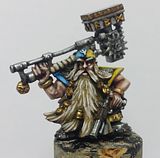Games Workshop are very excited in White Dwarf 378 (June 2011 UK edition) about their new Citadel Finecast range of Warhammer (and 40k, LOTR) miniatures.
I've read all that GW have had to say (they devote the first 17 pages of White Dwarf to the subject) and I've been doing a little google research and discussing the subject with other gamers and miniature producers. I thought I'd post my findings here because I'm fairly sure a lot of Warhammer fans out there want to know the bottom line on this and the actual practical differences between metal minis and their Finecast (resin) counterparts.
Now, first of all, I should apologize because it turns out that resin models are not necessarily cheaper than metal ones to produce (which I suggested in this post about Finecast prices). I'm not certain because I'm reading different opinions in different places but one of the more reliable (in my assessment) comes from someone involved with sculpting and molding miniatures for sale. They say that for them, resin is currently a little more expensive although metals prices are rising much faster than resin prices.
In another discussion there was also talk about resin being a lot lighter (in weight) and thus cheaper to ship in and out. Also energy costs might be lower to produce the minis but wastage costs are probably higher. All in all, the jury is still out as to whether the Finecast miniature price rises are justified.
Anyway, let's focus on the non-cost differences between lead/tin/metal and indeed plastic miniatures versus Citadel's Finecast resin range. Here goes...
Detail
- GW say that their Finecast range "...offer a level of detail that surpasses anything else" (page 17 White Dwarf 378 June 2011). From checking out as many close up pics I can find the minis look really crisp. The edges look sharp and the flat bits... flat like they should be while some of the detail does appear more intricate than we're used to with metal models.
Assembly
- Resin miniatures are much easier to assemble than metals! Large models can be super-glued rather than "pinned" (or epoxied !) I get the impression that the bonding is likely to be stronger than with plastics because the resin is slightly porus (although I might be making a wrong assertion). The resign is also malleable when heated so you can warm parts up in hot water or on a radiator or using a hair dryer and then gently manipulate the arms, legs, head, weapons etc. into new positions. Resin has more "give" than plastic and is less likely to snap.
Painting
- Lighter than metal and thus easier to paint large models (such as a dragon) because they can be held steady in the hand and in the same position for longer (before your wrist snaps !) Apparently, resin models are visually easier to paint, there is less glare because they are not glossy / shiny and therefore it's easier to pick out the detail.
Other plus points
- A damn site lighter and easier to transport to battles and tournaments than metal models
The future
- Resin should allow the miniature designers to experiment more. Things that weren't possible before with metal (because of the weight of extended limbs, weapons and such) are now feasible with resin and can be reproduced to the same or better level of detail.
My opinion...
I'm beginning to warm to this resin miniatures idea because there clearly are some added benefits. I am however a bit concerned about the price increases, they seem a little bit steep to me, esp given that people are tightening their belts somewhat these days. Still, I think resins will probably mostly be for the one-off purchases of special characters and rare units. Most armies will be predominantly plastic in any case.
Here are some pics, all from the Games Workshop site, check out the fine detail. Also, note that there are quite a few Tomb King miniatures in the Finecast range (on advance order - more about that in a later post), nice timing with the release of the new army book for anyone starting a new TK army.
Images are © Games Workshop. All rights reserved. Used without permission.


















































